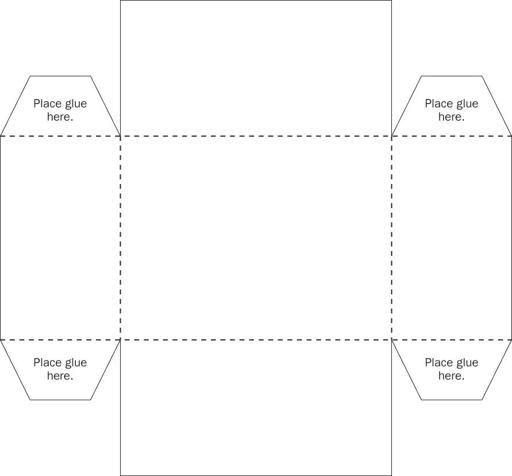Teaching the Common Core Math Standards With Hands-On Activities, Grades 3-5 (88 page)
Read Teaching the Common Core Math Standards With Hands-On Activities, Grades 3-5 Online
Authors: Judith A. Muschla,Gary Robert Muschla,Erin Muschla-Berry
Tags: #Education, #Teaching Methods & Materials, #Mathematics, #General

BOOK: Teaching the Common Core Math Standards With Hands-On Activities, Grades 3-5
6.78Mb size Format: txt, pdf, ePub
Closure
Ask your students to write an explanation of how the formularelates to the formula
. After they are done, ask volunteers to share their explanations. Students should realize that the formulas are equivalent because
equals the area of the base, which multiplied by the height equals the volume of the prism.
Activity 3: Packing Rectangular Prisms
Working in groups, students will be given a cardboard box that they will fill with smaller boxes. They will find the total volume of the smaller boxes and the volume of the larger box. They will also find the volume of any unfilled space in the larger box.
Materials
One cardboard box about 1 foot by 1 foot by 1 foot for each group; several small empty cardboard boxes; rulers; markers for each group.
Preparation
Obtain enough cardboard boxes measuring about 1 foot by 1 foot by 1 foot for each of your groups. Ask your students to bring in small, empty, clean cardboard boxes from home, for example cereal boxes, tissue boxes, tea bag boxes, pasta boxes, shoe boxes, and so on. Each group should have about 10 boxes of various sizes. To facilitate storage, store smaller boxes in larger ones. (
Note:
If groups have extra boxes, they may share them with other groups.)
Procedure
1.
Explain to your students that they are to fill the large cardboard box with smaller boxes, leaving the least amount of empty space.
2.
Instruct your students to find the volume of their large box by measuring the dimensions of the box and then using either of these two formulas:or
. After finding the volume of the large box, students should write the volume on the box.
3.
Now instruct your students to find the volume of each smaller box, using the same procedure. They should write the volume on each box.
4.
Explain that students are to fill the larger box with as many of the smaller boxes as possible without any boxes extending over the top of the large box. They should try to fill the large box so that no empty space (or as little space as possible) remains. If students are having trouble filling the large box, suggest that they find the sum of the volumes of various small boxes that might approximately equal the volume of the large box. This may help to reduce trial and error while filling the large box.
5.
Tell your students that after they have found the sum of the volumes of the boxes that fit into the large box, they are to find the volume of any unfilled space.
6.
If time permits, have students work with the boxes of another group and have the students compare their results.
Closure
Discuss students' results. Ask questions such as the following: Did anyone have no unfilled space after packing the large box with the smaller boxes? If no group found this result, determine which group had the least amount of unfilled space. Did they try to rearrange the smaller boxes to reduce any unfilled space? Discuss why the sum of the volume of the smaller boxes might equal the volume of the large box but might not have fit inside the large box.
Rectangular Prism Net
Geometry: 5.G.1
“Graph points on the coordinate plane to solve real-world and mathematical problems.”
1. “Use a pair of perpendicular number lines, called axes, to define a coordinate system, with the intersection of the lines (the origin) arranged to coincide with the 0 on each line and a given point in the plane located by using an ordered pair of numbers, called its coordinates. Understand that the first number indicates how far to travel from the origin in the direction of one axis, and the second number indicates how far to travel in the direction of the second axis, with the convention that the names of the two axes and the coordinates correspond (e.g.,-axis and
-coordinate,
-axis and
-coordinate).”
Other books
Temptation Rising by Arthur, A.C.
The Vampire's Seduction by Raven Hart
Criminal by Helen Chapman
Kiss the Moon by Carla Neggers
This Monstrous Thing by Mackenzi Lee
Jacques the Fatalist: And His Master by Denis Diderot
Slag Attack by Prunty, Andersen
Memorias de África by Isak Dinesen
French Quarter by Stella Cameron
Snatchers (Book 9): The Dead Don't Scream by Whittington, Shaun

